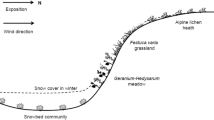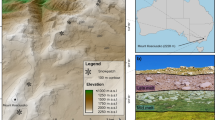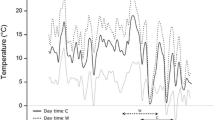Abstract
Seed germination profoundly impacts plant community composition within the plant life cycle. Snow is an important source of water for seed germination in the temperate deserts of Central Asia. Understanding how seed germination responds to variations in snow cover in relation to seed traits and plant ecological characteristics can help predict plant community sustainability and stability in Central Asia under a scenario climate change. This study investigated the seed germination of 35 plant species common to the Gurbantunggut Desert in Central Asia under the three snow treatments: (1) snow addition; (2) ambient snow; and (3) snow removal. Two-way analysis of variance (ANOVA) tests were performed to assess interactions among the impacts of snow treatments, seed traits and plant ecological characteristics on seed germination. Phylogenetic generalized least-squares (PGLS) model was used to test the relationships between seed traits and seed germination. The results demonstrated that snow variations had no significant impacts on seed germination overall. Seed germination under the snow addition treatment was similar with that under the ambient snow treatment, irrespective of seed traits and plant ecological characteristics. Snow removal only had negative impacts on seed germination for certain groups of seed traits and plant ecological characteristics. Seed mass positively affected seed germination, showing a linear increase of arcsin square root-transformed seed germination with log-transformed seed mass. Seed shape also profoundly impacted seed germination, with a higher germination percentage for elongated and flat seeds. Seed germination differed under different plant life forms, with semi-shrub species showing a significantly higher germination percentage. Most importantly, although snow treatments, seed traits and plant ecological characteristics had no interactive effects on seed germination overall, some negative impacts from the snow removal treatment were detected when seeds were categorized on the basis of seed mass and shape. This result suggests that variations of snow cover may change plant community composition in this temperate desert due to their impacts on seed germination.
Similar content being viewed by others
References
Abbott L B, Roundy B A. 2003. Available water influences field germination and recruitment of seeded grasses. Journal of Range Management, 56(1): 56–64.
Arfin-Khan M A S, Vetter V M S, Reshi Z A, et al. 2018. Factors influencing seedling emergence of three global invaders in greenhouses representing major eco-regions of the world. Plant Biology, 20(3): 610–618.
Baskin J M, Baskin C C, Li X J. 2000. Taxonomy, anatomy and evolution of physical dormancy in seeds. Plant Species Biology, 15(2): 139–152.
Bilbrough C J. 2000. Early spring nitrogen uptake by snow-covered plants: A comparison of Arctic and alpine plant function under the snowpack. Arctic, Antarctic, and Alpine Research, 32(4): 404–411.
Blomberg S P, Garland T, Ives A R. 2003. Testing for phylogenetic signal in comparative data: Behavioral traits are more labile. Evolution, 57(2): 717–745.
Bu H Y, Chen X L, Xu X L, et al. 2007. Seed mass and germination in an alpine meadow on the eastern Tsinghai-Tibet plateau. Plant Ecology, 191(1): 127–149.
Bu H Y, Du G Z, Chen X L, et al. 2008. Community-wide germination strategies in an alpine meadow on the eastern Qinghai-Tibet plateau: Phylogenetic and life-history correlates. Plant Ecology, 195(1): 87–98.
Catoni R, Granata M U, Sartori F, et al. 2015. Corylus avellana responsiveness to light variations: Morphological, anatomical, and physiological leaf trait plasticity. Photosynthetica, 53(1): 1–12.
Chao X X, Sun Y. 2016. Effects of different treatments on Nymphoides indica seed germination. Chinese Agricultural Science Bulletin, 32(34): 80–84. (in Chinese)
Chen W N, Chen F J, Xie Y H. 2013. Effects of snowmelt time on growth of Fritillaria unibracteata. Hubei Agricultural Sciences, 52(4): 868–872. (in Chinese)
Chen Z H, Peng J F, Zhang D M, et al. 2002. Seed germination and storage of woody species in the lower subtropical forest. Acta Botanica Sinica, 44(12): 1469–1476.
Constable J V H, Peffer B J, DeNicola D M. 2007. Temporal and light-based changes in carbon uptake and storage in the spring ephemeral Podophyllum peltatum (Berberidaceae). Environmental and Experimental Botany, 60(1): 112–120.
Decker K L M, Wang D, Waite C, et al. 2003. Snow removal and ambient air temperature effects on forest soil temperatures in northern Vermont. Soil Science Society of America Journal, 67(4): 1234–1242.
Dorrepaal E, Aerts R, Corenlissen J H, et al. 2004. Summer warming and increased winter snow cover affect Sphagnum fuscum growth, structure and production in a sub-arctic bog. Global Change Biology, 10(1): 93–104.
Drescher M, Thomas S C. 2013. Snow cover manipulations alter survival of early life stages of cold-temperate tree species. Oikos, 122(4): 541–554.
Drescher M. 2014. Snow cover manipulations and passive warming affect post-winter seed germination: A case study of three cold-temperate tree species. Climate Research, 60(3): 175–186.
Fan L L, Ma J, Wu L F, et al. 2012. Response of the herbaceous layer to snow variability at the south margin of the Gurbantonggut Desert of China. Chinese Journal of Plant Ecology, 36(2): 126–135. (in Chinese)
Fan L L, Li Y, Tang L S, et al. 2013. Combined effects of snow depth and nitrogen addition on ephemeral growth at the southern edge of the Gurbantunggut Desert, China. Journal of Arid Land, 5(4): 500–510.
Fan L L, Tang L S, Wu L F, et al. 2014. The limited role of snow water in the growth and development of ephemeral plants in a cold desert. Journal of Vegetation Science, 25(3): 681–690.
Figueroa J A. 2003. Seed germination in temperate rain forest species of southern Chile: Chilling and gap-dependency germination. Plant Ecology, 166(2): 227–240.
Frenner M. 2000. Seeds: The Ecology of Regeneration in Plant Communities. New York: CABI Publishing, 31–57.
Funes G, Basconcelo S, Diaz S, et al. 1999. Seed size and shape are good predictors of seed persistence in soil in temperate mountain grasslands of Argentina. Seed Science Research, 9(4): 341–345.
Galindez G, Ortega-Baes P, Daws M I, et al. 2009. Seed mass and germination in Asteraceae species of Argentina. Seed Science and Technology, 37(3): 786–790.
Gordon E. 1998. Seed characteristics of plant species from riverine wetlands in Venezuela. Aquatic Botany, 60(4): 417–431.
Gornish E S, Aanderud Z T, Sheley R L, et al. 2015. Altered snowfall and soil disturbance influence the early life stage transitions and recruitment of a native and invasive grass in a cold desert. Oecologia, 177(2): 595–606.
Gremer J R, Venable L D. 2014. Bet hedging in desert winter annual plants: Optimal germination strategies in a variable environment. Ecology Letters, 17(3): 380–387.
Grime J P, Mason G, Curtis A V, et al. 1981. A comparative study of germination characteristics in a local flora. Journal of Ecology, 69(3): 1017–1059.
Gutterman Y. 2000. Phenotypic effects on seeds during development. In: Fenner M. Seeds: The Ecology of Regeneration in Plant Communities (2nd ed.). Wallingford: CABI Publishing, 25–77.
Hendry L B, Shucksmith J, Love J G, et al. 1993. Young People’s Leisure and Lifestyle. New Yock: Routledge, 1985–1989.
Houle G. 2002. The advantage of early flowering in the spring ephemeral annual plant Floerkea proserpinacoides. New Phytologist, 154(3): 689–694.
Huang G, Li Y. 2015. Phenological transition dictates the seasonal dynamics of ecosystem carbon exchange in a desert steppe. Journal of Vegetation Science, 26(2): 337–347.
Huang G, Li Y, Padilla F M. 2015. Ephemeral plants mediate responses of ecosystem carbon exchange to increased precipitation in a temperate desert. Agricultural and Forest Meteorology, 201(15): 141–152.
Huang G, Su Y G, Zhu L, et al. 2016. The role of spring ephemerals and soil microbes in soil nutrient retention in a temperate desert. Plant and Soil, 406(1–2): 43–54.
Huang G, Chen H L, Li Y. 2018. Phenological responses to nitrogen and water addition are linked to plant growth patterns in a desert herbaceous community. Ecology and Evolution, 8(10): 5139–5152.
Jia F Q, Zhang Y M, Tashpolat T, et al. 2017. Effect of snow thickness on seed germination of four ephemeral plants from the Gurbantunggut Desert of China. Seed, 36(2): 24–29. (in Chinese)
Keller F, Goyette S, Beniston M. 2005. Sensitivity analysis of snow cover to climate change scenarios and their impact on plant habitats in alpine terrain. Climatic Change, 72(3): 299–319.
Kreyling J, Haei M, Laudon H. 2012. Absence of snow cover reduces understory plant cover and alters plant community composition in boreal forests. Oecologia, 168(2): 577–587.
Lapointe L L L, Lerat S L S. 2006. Annual growth of the spring ephemeral Erythronium americanum as a function of temperature and mycorrhizal status. Canadian Journal of Botany, 84(1): 39–48.
Li X H, Jiang D M, Liu Z M, et al. 2006a. Germination strategies and patterns of annual species in the temperate semiarid region of China. Arid Land Research and Management, 20(3): 195–207.
Li X H, Jiang D M, Liu Z M, et al. 2006b. Seed germination characteristics of annual species in temperate semi-arid region. Acta Ecologica Sinica, 26(4): 1194–1199. (in Chinese)
Liu H L, Zhang D Y, Duan S M, et al. 2014. The relationship between diaspore characteristics with phylogeny, life history traits, and their ecological adaptation of 150 species from the cold desert of Northwest China. The Scientific World Journal, 2014(3): 149–168.
Liu Y X. 1992. Flora in Desertis Reipublicae Populorum Sinarum. Beijing: Science Press, 464. (in Chinese)
Liu Z M, Li X H, Li R P, et al. 2003. A comparative study on seed germination of 15 grass species in Keeqin Sandyland. Chinese Journal of Applied Ecology, 14(9): 1416–1420. (in Chinese)
Liu Z M, Li X H, Li R P, et al. 2004. A comparative study of seed germination for 31 annual species of the Horqin steppe. Acta Ecologica Sinica, 24(3): 648–653. (in Chinese)
Liu Z M, Jiang D M, Yan Q L, et al. 2005. Study on dispersal biology of common species of flora of the Horqin Steppe. Acta Prataculturae Sinica, 14(6): 23–33. (in Chinese).
Liu Z M, Yan Q L, Li X H, et al. 2007. Seed mass and shape-germination and plant abundance in a desertified grassland in northeastern Inner Mongolia. Journal of Arid Environments, 69(2): 198–211.
Lorenzi H. 2002. Brazilian Trees: A Guide to the Identification and Cultivation of Brazilian Native Trees, Nova Odessa. São Paulo: Instituto Plantarum de Estados da Flora, 352. (In Portuguese)
Moles A T, Hodson D W, Webb C J. 2000. Seed size and shape and persistence in the soil in the New Zealand flora. Oikos, 89(3): 541–545.
Pagel M. 1999. Inferring the historical patterns of biological evolution. Nature, 401(28): 877–884.
Paradis E, Claude J, Strimmer K. 2004. APE: Analyses of phylogenetics and evolution in R language. Bioinformatics, 20(2): 289–290.
Paz H, Mazer S J, Martinez-Ramos M. 1999. Seed mass, seedling emergence, and environmental factors in seven rain forest Psychotria (Rubiaceae). Ecology, 80(5): 1594–1606.
Pinheiro J, Bates D, DebRoy S, et al. 2019. Nlme: Linear and Nonlinear Mixed Effects Models. [2020–08-23]. https://cran.r-project.org/package=nlme.
Rees M. 1994. Delayed germination of seeds: A look at the effects of adult longevity, the timing of reproduction, and population age/stage structure. American Naturalist, 144(1): 43–64.
Reich P B. 1994. Seed mass effects on germination and growth of diverse European Scots pine populations. Canadian Journal of Forest Research, 24(2): 306–320.
Simons A M, Goulet J M, Bellehumeur K F. 2010. The effect of snow depth on overwinter survival in Lobelia inflata. Oikos, 119(10): 1685–1689.
Soriano D, Orozco-Segovia A, Márquez-Guzmán J, et al. 2011. Seed reserve composition in 19 tree species of a tropical deciduous forest in Mexico and its relationship to seed germination and seedling growth. Annals of Botany, 107(6): 939–951.
Sun Y, Zhang T, Tian C Y, et al. 2009. Response of grass growth and productivity to enhanced water input in Gurbantunggut Desert. Acta Ecologica Sinica, 29(4): 1859–1868. (in Chinese)
Tekrony D M, Shande T, Rucker M, et al. 2005. Effect of seed shape on corn germination and vigour during warehouse and controlled environmental storage. Seed Science and Technology, 33(1): 185–197.
Thompson K, Band S R, Hodgson J G. 1993. Seed size and shape predict persistence in soil. Functional Ecology, 7(2): 236–241.
Thompson K, Bakker J, Bekker R M, et al. 1998. Ecological correlates of seed persistence in soil in the North-West European flora. Journal of Ecology, 86(1): 163–169.
van Mölken T, Jorritsma-Wienk L D, van Hoek P H W, et al. 2005. Only seed size matters for germination in different populations of the dimorphic Tragopogon pratensis subsp. pratensis (Asteraceae). American Journal of Botany, 92(3): 432–437.
Wang J H, Baskin C C, Cui X L, et al. 2009. Effect of phylogeny, life history and habitat correlates on seed germination of 69 arid and semi-arid zone species from Northwest China. Evolutionary Ecology, 23(6): 827–846.
Wang Z N, Wang L X, Liu Z M, et al. 2016. Phylogeny, seed trait, and ecological correlates of seed germination at the community level in a degraded sandy grassland. Frontiers in Plant Science, 7(351): 1532–1562.
Webb C O, Donoghue M J. 2005. Phylomatic: Tree assembly for applied phylogenetics. Molecular Ecology Notes, 5(1): 181–183.
Weiher E, van der Werf A, Thompson K R, et al. 1999. Challenging Theophrastus: A common core list of plant traits for functional ecology. Journal of Vegetation Science, 10(5): 609–620.
Weltzin J F, Mcpherson G R. 2000. Implications of precipitation redistribution for shifts in temperate savanna ecotones. Ecology, 81(7): 1902–1913.
Westoby M, Jurado E, Leishman M R. 1992. Comparative evolution ecology of seed size. Trends in Ecology & Evolution, 7(11): 368–372.
Wu G L, Du G Z. 2007. Germination is related to seed mass in grasses (Poaceae) of the eastern Qinghai-Tibetan Plateau, China. Nordic Journal of Botany, 25(5–6): 361–365.
Xu J, Li W L, Zhang C H, et al. 2014. Variation in seed germination of 134 common species on the eastern Tibetan Plateau: phylogenetic, life history and environmental correlates. PLoS ONE, 9(6): e98601, doi: https://doi.org/10.1371/journal.pone.0098601.
Yan D R, Bai W C, Bao C, et al. 2012. The factors influencing natural regeneration of Pinus sylvestris var. mongolica in sandy land. Journal of Inner Mongolia Forestry Science and Technology, 38(4): 47–50. (in Chinese)
Yuan S F, Tang H P. 2010. Patterns of ephemeral plant communities and their adaptations to temperature and precipitation regimes in Dzungaria Desert, Xinjiang. Biodiversity Science, 18(4): 346–354. (in Chinese)
Zanne A E, Tank D C, Cornwell W K, et al. 2014. Three keys to the radiation of angiosperms into freezing environments. Nature, 506(56): 89–92.
Zhang L Y, Chen C D. 2002. Study on the general characteristics of plant diversity of Gurbantunggut sandy desert. Acta Ecologica Sinica, 22(11): 1923–1932. (in Chinese)
Zhao J, Song Y, Sun T, et al. 2012. Response of seed germination and seedling growth of Pinus koraiensis and Quercus mongolica to comprehensive action of warming and precipitation. Acta Ecologica Sinica, 32(24): 7791–7800. (in Chinese)
Zheng Y, Xie Z, Yu Y, et al. 2005. Effects of burial in sand and water supply regime on seedling emergence of six species. Annals of Botany, 95(7): 1237–1245.
Acknowledgements
The study was supported by the National Natural Science Foundation of China (41571256, 31670007). Two anonymous reviewers provided comments that improved the manuscript. We thank Dr. CHENG Junhui from Xinjiang Agricultural University for his valuable advice on R language analysis.
Author information
Authors and Affiliations
Corresponding author
Rights and permissions
About this article
Cite this article
Anniwaer, A., Su, Y., Zhou, X. et al. Impacts of snow on seed germination are independent of seed traits and plant ecological characteristics in a temperate desert of Central Asia. J. Arid Land 12, 775–790 (2020). https://doi.org/10.1007/s40333-020-0059-9
Received:
Revised:
Accepted:
Published:
Issue Date:
DOI: https://doi.org/10.1007/s40333-020-0059-9




